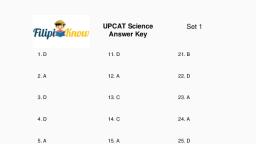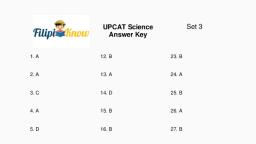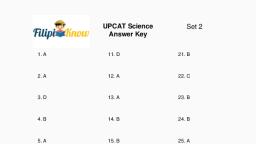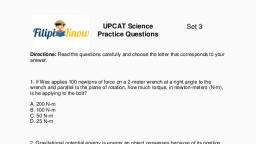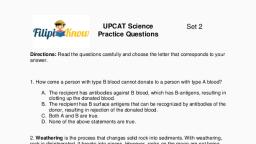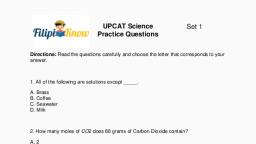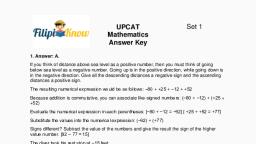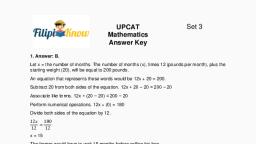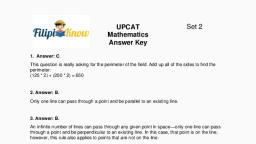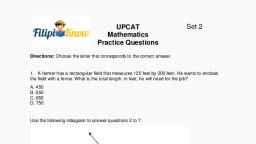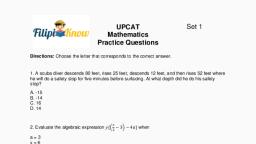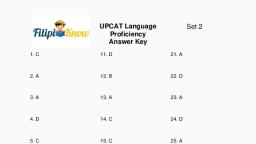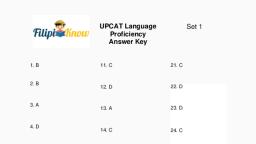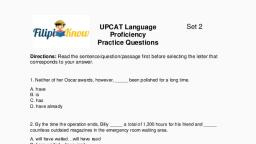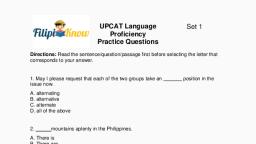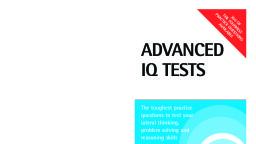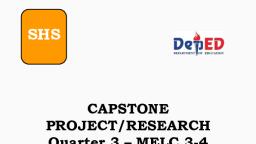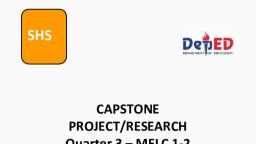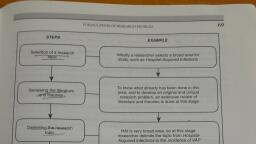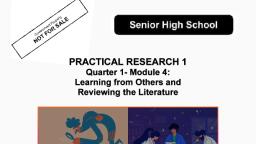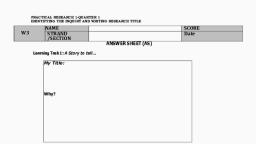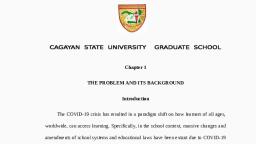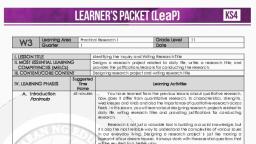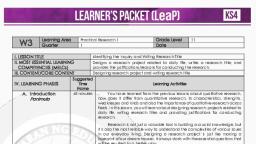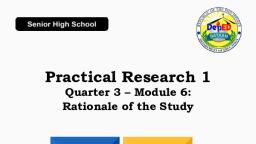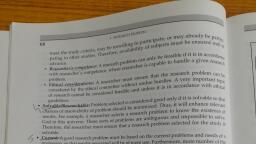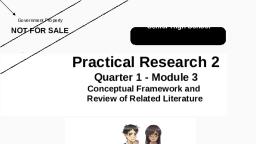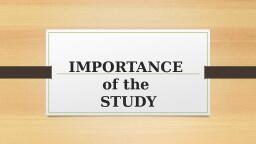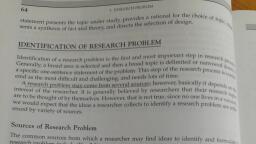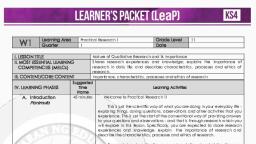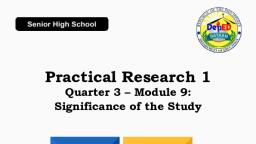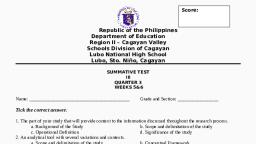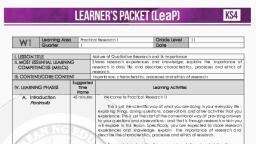Page 1 :
PRACTICAL RESEARCH 1, Quarter 1- Module 3:, Identifying the Inquiry and Stating the Problem
Page 2 :
Department of Education ● Republic of the Philippines
Page 3 :
Lesson, The Subject Matter of the Research, , 1, , Developing a good research topic may not be easy for you but it is an important skill. Your, teacher may assign you a particular topic but often requires you to choose a topic that interests you., In this lesson, you are given the guidelines for choosing a topic when you begin your research work., These pointers will guide you in selecting a good topic. Other factors affecting in choosing and writing, your research are topics that need to be avoided this will help you focus clearly on your subjects., Likewise, the sources of information are important for you to know where your research topic may, come from., , What’s New?, , I. What is a Research Title1?, 1. The most important element that defines the research problem., 2. It is usually read first and the most read part of the research., 3. It contains the least words enough to describe the contents and the purpose of your research, paper., 4. It can be revised any and many times as the research develops and reach its final phase. It, becomes final on its final defense before the panel of judges., ❖ Elements of a Research Title, The research title does not need to be entertaining but informative., A part of a research title has the following information:, 1. The subject matter or topic to be investigated. (“What?”), 2. The place or locale where the research is to be conducted. (“Where?”), 3. The population is like the respondents’ interviewees. (“Who”?), 4. The time period of the study during which the data are to be collected. (“When”?), Example:, Subject matter: The teaching of English, Place or locale: in the high schools of Province A, Time period: during the school year 1989-1990, Population: as perceived by teachers and students, Subject matter: The effects of the use of cell phones on the academic performance, Population to senior high school students, Place or locale: at Department of Education, Time period: during the first semester, school year 2018-2019, II. Rules in Choosing a Research Topic1, 1. Interest in the subject matter. Interest in a subject drives you to research, investigate, or inquire, about it with full motivation, enthusiasm, and energy., , 2
Page 4 :
2. Availability of information. Information will serve as evidence to support your claims about your, subject matter from varied forms of literature like books, journals, and newspapers, among others, is a, part and parcel of any research work., What to include in the investigation of the available materials?, a. Update and authority of the materials., b. Copyright dates of the materials? Are they new or old?, c. Expert or qualification of the writers of reading materials about your topic, 3. Timeliness and relevance of the topic., How relevant is the topic?, a. It yields results that are useful in society, b. Related to the present. (Except for pure or historical research), 4. Limitations on the subject. Connect your choice with course requirements. You need to decide on, one topic to finish your course., 5. Personal resources. Do an assessment on your research abilities in terms of your financial, standing, health condition, mental capacity, needed facilities, and time schedule to enable you to, complete your research. You have to raise an amount of money needed to spend on questionnaire, printing and interview trips., III. Research Topics to be avoided1, 1. Controversial topics., It depends more on the writer’s opinion leading to biases. Facts cannot support this topic., 2. Highly technical subjects., Not advisable for beginners as these topics require an advanced study, technical knowledge, and, skills., 3. Hard-to-investigate subjects., Happens if there are no available reading materials about it and if such materials are not up-to-date., 4. Too broad subjects., It prevents you from to focus on the subject matter of the paper., Narrow down or limit the subject to eliminate the problem., 5. Too narrow subjects., Subjects that are so limited where an extensive searching is necessary., 6. Vague subjects., Titles beginning with indefinite adjectives such as several, many, some, etc., as in “Some, Remarkable Traits of a Filipino” or “Several People’s Comments on the RH Law,” are vague enough, to decrease the readers’ interests and curiosity., IV. Sources of Research Topics1, 1. Mass media communication – press (newspapers, ads, TV, radio, films, etc.), 2. Books, Internet, peer-reviewed journals, government publications, 3. Professional periodicals like College English Language Teaching Forum, English Forum, the, Economist, Academia, Business Circle, Law Review, etc., , 3
Page 5 :
4. General periodicals such as Readers’ Digest, Women’s Magazine, Panorama Magazine, Time, Magazine, World Mission Magazine, etc., 5. Previous reading assignments in your other subjects, 6. Work experience – clues to a researchable topic from full-time or part-time jobs, OJT (on-the-job, training) experience, fieldwork, etc., , What’s more?, , Narrowing Your Topic, Given the following broad topics for research, select one topic of your choice and narrow or limit the, topic to make it specific. Use the narrowing chart to fill in the topic., Topics to choose:, 1. Climate Change, 2. Social Networking, 3. Communication Skills, 4. Medicinal Plants, 5. Cultural Beliefs, Example: Topic, Chocolate, Topic, , Chocolate, , Sub-Topics, , History of chocolate, making of chocolate, health, aspects of chocolate, chocolate addictions,, brands of chocolate, , What sub-topics are of most interest to you?, , Health aspects of chocolate., , What new questions do you have about your, topic?, , Are there health benefits to eating chocolate?, Can chocolate boost your mood? Is chocolate, addictive?, , Develop a topic statement, , I will explore the health benefits of eating, chocolate, specifically focusing on how chocolate, affects moods and brain chemistry., , Narrowing Chart, Topic, Sub-Topics, What sub-topics are of most interest to you?, What new questions do you have about your, topic?, Develop a topic statement, , 4
Page 6 :
What I have learned, Think of this statement: A good research is seen in the way its topic is outlined. When you choose, topics for your research, you have to think about the reasons why you identified those topics., How will you write a good research topic?, _________________________________________________________________________________, _________________________________________________________________________________, _________________________________________________________________________________, _________________________________________________________________________________, _________________________________________________________________________________, _________________________________________________________________________________, __________________________________________________, , What I can do, Recall or search on the following as a research topic:, a. Essays or reflections you have written from past classes and other activities you have taken, or a lecture you have attended, b. Life experiences, c. Issues or problems observed in your surroundings, Thinking back, what subject matter is most interesting to you?, Propose a title out of the above research topics. Write your title in the spaces provided. (Save the, titles for the additional activity to be done), _________________________________________________________________________________, _________________________________________________________________________________, _________________________________________________________________________________, , Additional Activity, , From the topics or titles you had saved, browse through some current articles that relates to the, subject matter that interest you to research. Read and summarize the topic using the narrowing chart, on page 9 of this lesson. It is important that you save this task for your next lesson., , 5
Page 7 :
Lesson, , The Research Problem and, , 2, , Research Question, What’s New?, , I. An Overview of the Research Problem and Research Question, Chapter I of the research paper is called The Problem and Its Background (sometimes also called, The Introduction), ❖ It is composed of the following sections:, 1) Background of the Study,, 2) Statement of the Problem,, 3) Scope and Delimitation, and, 4) Significance of the Study., Others have sections such as Objectives of the Study, Hypotheses but these will not be considered in, this lesson, What is a research problem?, ❖ The Research Problem (According to Calderon & Gonzales,1993), A problem is “any significant, perplexing, and challenging situation, real or artificial, the solution of, which requires reflexive thinking”. In research, it is known as the research topic or research title., An illustration showing the description between a research topic, research problem, purpose, statement, and research question., General, , A research topic is the, broad subject matter, of the study, , Topic: Distance Learning, , A research problem is, a general issue or, concern about the, research that narrow, the topic., A purpose of the, study used to address, the problem., , Research Problem:, Lack of learners’ knowledge about, distance in distance education., , Purpose Statement:, To study why learners do not attend, distance education classes in a, community college, , A research question, narrows the purpose, into specific questions, that the researcher, would like to answer, in the study, , Research Questions:, , Specific, 6, , Does the use of website technology, in the classroom deter learners from, enrolling in a distant education, class?
Page 8 :
A. Background of the Study, ❖ Purpose of the background of the study, a., b., c., d., , The general definition of the topic/problem area, The historical basis for the existence of the problem, Efforts made towards addressing similar challenges, How the efforts failed to be realized hence the need for your study, , ❖ Contents of the background of the study:, a. Presentation of the problem. Describe the existence of an unsatisfactory condition or a, problem that needs a solution., b. Historical background of the problem - Give the historical background of the the problem, if, applicable., c. Geographical conditions of the study locale - If applicable, describe the the geographical, location of the study., d. Rationale of the study - Give the reason(s) why the study should be conducted., Example:, , In 2004, the researcher migrated to the Philippines to accompany her spouse, who was at the time studying at the Adventist Institute for International Advanced, Studies (AIIAS) in Silang, Cavite. They discovered the study opportunities and, were motivated by the quality of education and low school fees being offered., They visited several colleges and universities to collect pamphlets and sent them, back to Vanuatu for educational awareness. The Ni-Vanuatus became aware, and decided to send students to study in the Philippines. The first two schools to, receive Vanuatu students were AMA Computer College in Dasmariñas, Cavite, and Air Link Aviation College in Paranaque City. The researcher came to know, Cavite State University (CvSU) in 2009 and transferred from AMA., (Ngwele, March 2011), ❖ The Do’s and Don’ts of Writing a Research Background Study, , 1, , (Ngwele, March 2011), ✓, ✓, ✓, ✓, ✓, ✓, , Do‘s!, Explain the importance of your, research topic, Talk about the main developments, and missing links and gaps in your, research area, Focus on the relevant aspects of your, study explaining how it will lead to the, progress of scientific knowledge., Engage your findings in chronological, findings, Articulate your ideas in a clear and, concise manner, Engage the readers by building a story, around the central theme of your, research, , o, o, o, , 7, , Don’ts!, Write a background that is too long or, short, Be, ambiguous, in, your, writing,, disorganized, and discuss unrelated, subjects., Forget the reader may not be familiar, with the details of your work., , o, , Elaborate on your background literature, , o, , Forget to provide a historical perspective, , o, , Forget to check your target journal’s, instruction for presenting the study, background
Page 9 :
B. Statement of the Problem, (Purpose Statement and Research Questions), A series of questions were used in researching the topic., It is composed of, 1. The general statement of the problem (the purpose statement) and, 2. The specific sub-problems or sub-questions (or research questions)., ❖ Guidelines in Writing the Statement of the Problem, (According to Calderon & Gonzales,1993), 1. The general statement of the problem and the research questions should be formulated first before, conducting the research., 2. Research questions should be stated in the interrogative and each should be clear to avoid, confusion., 3 Each research question should be researchable separately from the other questions and must be, based upon known facts and phenomena which is accessible to the researcher., 4. Answers to each research question can be interpreted apart from the answers to the other specific, questions and must contribute to the development of the whole research study., 8. The summary of the answers to all the specific questions will give a complete development of the, entire study., 9. The number of research questions should be enough to cover the development of the whole, research study., Example:, , This research aims to develop an evaluation model of a web-based tool used in, test administration for Grade 11 and 12 students. (Leanillo, 2016), Specifically it aims to answer the following questions:, 1. What are the commonly used web-based tools used in test administration?, 2. How are these web-based test tools evaluated?, 3. How, could the, evaluation model be designed for web-based test, IV.Sco, and Delimitation, of Research, administration?, C. Scope and Delimitation of the Study1, ❖ Scope of a Study, It is the coverage of the research to be explored which includes the facts and theories about the, subject, Example:, A research study on the impact of social networking on the attitude of senior high school learners., , 8
Page 10 :
It is not possible to cover all aspects of the selected subject. The scope will have to be restricted to a, specific section of the target population over a specified duration., In the above-cited study, a group of 40 learners in senior high school at one particular school would, be an ideal coverage to study their attitude for five months., ❖ Delimitation of a Study, It limits the scope and outlines the boundaries of the study., These limitations include the following:, 1. Sample size., a. The research design and method will determine whether it is a small or large sample size., b. The sample size will determine the quality of data and the relationships that will be, identified among the variables., 2. Lack of available and/or reliable data., This will limit the scope of analysis and the ability of the researcher to determine, meaningful trends and relationships among the data., 3. Lack of prior studies., This will limit the effectiveness of the literature review and initial understanding of the, research., 4. Chosen data collection method., The quality of data collected must be clear to avoid erroneous answers from the, respondents., 5. Nature of the information collected., Researchers should not rely on pre-existing data., 6. Access., The amount and quality of available data will depend on the ability of the researcher to, access people, organizations, libraries, and documents., 7. Time period., It is advisable to select a research problem and design, 8. Bias., The researcher should be aware of his or her personal biases., 9. Language., This may have an effect on data collection, especially if the researcher is involved with, respondents that speak a variety of languages., When writing the paper, the researcher should ensure that any delimitation factor is noted, down in the introduction, discussion, and conclusion sections. He or she should clarify why the study, included and excluded some delimitations., D. Significance of the Study, ❖ The significance of the study discuss the purpose that the research will serve to society, the, country, the government, the institution or agency concerned, the curriculum planners and, developers, and the research community., 9
Page 11 :
❖ Describes the contribution of the study to the existing body of knowledge., It could be the following:, a. A form of new knowledge in the field,, b. Validation of the major findings of other studies,, c. Verification of the validity of findings in a different population,, d. Analysis of trends over time, and validation of other findings using different methodologies., ❖ The researcher must identify specifically the beneficiaries who will directly gain from the, results of the study mentioning them in the paper according to the significance of the result., The specific benefits must also be enumerated and explained if necessary., Example:, The Effects of Computer-assisted Instruction in the Performance of Students in, Asian History and Civilization (Cuenca, 2008), The findings of the study may provide deeper insights on how teaching can be made, easier and more meaningful by the use of computer-aided instruction. The study determined the, significant effects of slide presentation in instruction, a form of computer instruction on the, performance of the students in the subjects Asian History and Civilization., To the students, the results may serve as an inspiration for them to continuously, improve their skills in using computers because they will realize the comfort that computer skills, offer in complying with the requirements of major subjects in the coming years., To the administrators, the results may serve as a guide in the program-planning and, implementation of the IT department so that they can be of great help to the teachers of the, university., To the teachers, the results may serve as an eye opener for those who are not, comfortable on the use of computers in their class lesson presentations. The findings of this, may encourage, more of them, to apply, computer-aided instruction in teaching., II.study, Presenting, Written Statement, of the, Problem, The following sections compose the presentation of the written statement of the problem, 1. Introduction, States briefly the background of the study and identifies the rationale of the research problem., It begins with a general statement of the problem, outlines the specific problem or issue within, the existing literature., 2. Statement of the Problem, States clearly the purposes or interest of the study, poses specific questions about research, problem., 3. Scope and Delimitation, Sets the boundaries and parameters of the study, narrows the scope of the inquiry., 4. Significance of the Study, Shows the benefits of the study to address issues and l problems, in improving economic and, health conditions or even finding solutions to problems encountered in daily lif, 10
Page 12 :
What’s more?, Follow the instructions below in doing this activity., A. Situation: Imagine yourself as a businessman in the picture shaking hands with a prospective, client., 1. How will you introduce yourself? Write your answer in NOT less than three (3) sentences., __________________________________________________________________________, __________________________________________________________________________, __________________________________________________________________________, ., , https://www.stockunlimited.com/vector-illustration/businessman-shaking-hands-silhouette, , 2. In general, what is the purpose of the introduction? Identify the basics of proper, introduction by using the graphic organizer below., , INTRODUCTION, , 11
Page 13 :
B. Synthesize your ideas and create a caption on the picture below., , https://www.stockunlimited.com/vector-illustration/targetboard, 1. What is your interpretation of the picture? What does the target board mean relative to, research?, _______________________________________________________________________, _______________________________________________________________________, _______________________________________________________________________, 2. Relate the picture in conducting research., _______________________________________________________________________, _______________________________________________________________________, ______________________________________________________________________, , What I can do, From your proposed research study present your written Statement of the Problem which, comprises the following sections:, I., , Background of the Study (Introduction), _______________________________________________________________________, _______________________________________________________________________, _______________________________________________________________________, , II., , Statement of the Problem, _______________________________________________________________________, _______________________________________________________________________, _______________________________________________________________________, , III., , Scope and Delimitation of the Study, _______________________________________________________________________, _______________________________________________________________________, _______________________________________________________________________, , 12
Page 14 :
IV., , Significance of the Study, __________________________________________________________________________, __________________________________________________________________________, __________________________________________________________________________, , Additional Activities, , After presenting Chapter 1 of your research study, edit or rewrite your work using the, corrections, suggestions and recommendations made by your teacher. Save your work for the, next lesson. Use the empty space provided., This page is intentionally empty as a space provided on rewriting of the research manuscript., , 13

